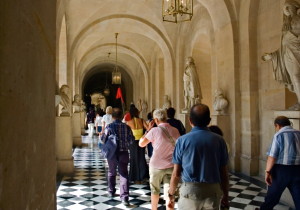Which is best — travelling with a group or going it alone? Here are some pros and cons . . . .
Going with a group
Travelling with a group is the easiest option, especially for a first trip to the Holy Land — and even more so if you are unused to foreign travel. Then if you want to return independently, you know the lie of the land.
Advantages include:
• Someone else does the planning, so you do not have to decide where to stay, what to see and how to get around.
• You have the companionship of others with like interests and beliefs. If you need help, you are among friends.
• For women especially, group travel overcomes the problems that a lone traveller faces in some Middle Eastern countries.
• Group travel is usually pre-paid, so you have better control of the cost.
• If visas are required, your travel agent will usually arrange these.
• You do not have to find your own way to sites, or pay entrance fees.
• Your guide will know the local environment, customs and language — and will point out aspects of a site that you might have overlooked.
• If a problem arises — with accommodation or transport, for example — it’s someone else’s problem (and you might never even know about it).
• On a group pilgrimage you will probably see more in a limited time than you would on your own.
Disadvantages include:
• Where the group goes, you go. You may be able to opt out of some days or half-days, but usually you must follow the programme.
• You may have to waste time waiting for stragglers who cannot keep up with the timetable.
• If personalities clash within the group, your patience may be tested.
Going it alone
When you travel on your own you have the freedom to plan your own itinerary, choose where to stay, make your own bookings and decide how to travel about.
Advantages include:
• You can be much more flexible in changing your plans. Some of your most memorable experiences may come from spontaneous decisions.
• Up-to-date guide books or websites can provide a host of information about places you want to visit and places to stay (see below for a link to opening hours of holy places and a list of Christian guesthouses).
• While travelling independently you can still take advantage of day trips organised by local agencies, especially to visit hard-to-find places.
• You will be much more likely to experience personal encounters with local people, their customs and lifestyles.
Disadvantages include:
• If you have not done your research adequately, you may miss out on some places you would have liked to see.
• Unless you are outgoing and can make friends easily, you may feel lonely as a solo traveller.
Doing it both ways
A third option for seeing the Holy Land is to combine group and independent travel. For example:
• Take a group pilgrimage, then spend a week staying in a hotel or hostel and travelling around independently. This gives the opportunity to see places that were not on the pilgrimage itinerary, or to return to places that particularly appealed. In Israel, for example, Jerusalem and the Galilee (using Tiberias or Nazareth as a base) offer much to see.
• Or take a group pilgrimage for your first visit to the Holy Land, then plan a second visit independently to focus on the places where you want to spend more time.
External links
Church services in the Holy Land; Opening hours of holy places; Christian guesthouses; Christian communities in the Holy Land . . . . (Christian Information Centre, Jerusalem)
Christian sanctuaries (Franciscan Custody of the Holy Land)
Photos and descriptions of biblical sites in Israel Jordan, Egypt, Turkey and Greece (BiblePlaces.com)
Israel Ministry of Tourism
Travel Palestine
Egyptian Tourist Authority
Jordan Tourism Board


